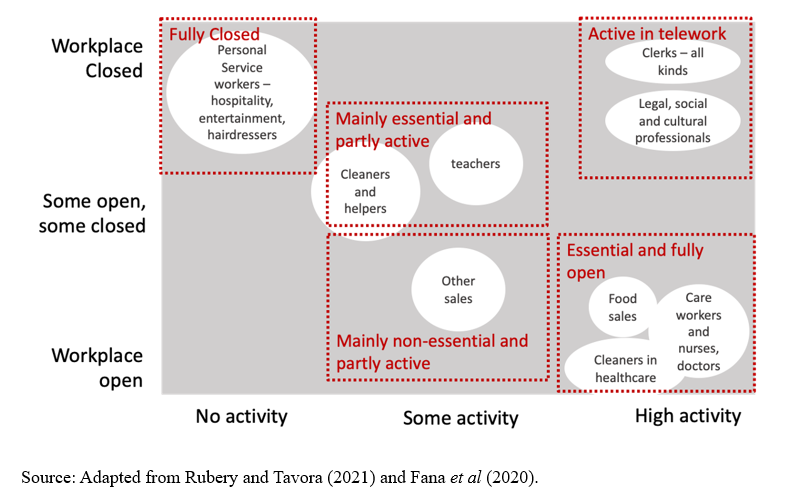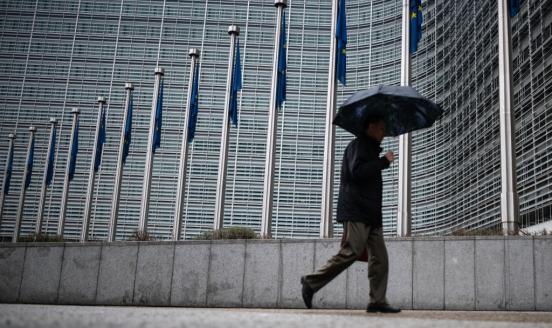Gender equality and reboundability in the labour market: lessons from COVID-19
Economic crises affect the jobs of men and women differently; steps can be taken to help all genders bounce back.

In previous recessions, men were more likely than women to lose their jobs, leading to the label “he-cession” (Nivakoski and Mascherini, 2021). Job losses were more severe in occupations in which men are over-represented, such as construction and manufacturing, in which, in the EU, men make up 90 percent and 70 percent respectively of total employees (Nivakoski and Mascherini 2021). In the aftermath of the 2008 Great Recession, however, the recovery period and austerity measures also negatively affected women’s employment as cuts were made to public-sector employment and provision of public services.
The COVID-19 pandemic differed from the Great Recession in many ways and scholars raised concerns about the disproportionately negative effect on women’s jobs – or a “she-cession” (Kim et al, 2021). Women are overrepresented in sectors that were hit severely by lockdowns, including hospitality, delivery of personal services and healthcare. The lockdowns in all European countries in early 2020 required conventional lives to be shifted into the digital sphere as much as possible because of physical distancing. Families had to organise home working, schooling, childcare and housework in parallel. Social theory suggests women were most severely affected by this shift, as traditional gender norms expect women to be the primary caregivers and men to be breadwinners. Furthermore, gender norms impact job segregation in labour markets and strongly affect the division of unpaid work.
The COVID-19 pandemic: a reset for gender equality?
Rubery and Tavora (2021) identified three factors that shaped the labour market in Europe during lockdowns and the early stages of reopening:
- Whether a physical workplace was opened or closed;
- Whether the level of demand was zero, reduced, unchanged or above pre-COVID-19 levels;
- Whether the work could be done from home.
They plotted developments in the most common female-dominated occupations in the EU during the COVID-19 lockdown on a two-dimensional scale, differentiating between the degree to which the workplace was open or closed, and the extent of the activity (Figure 1).
Figure 1: Working patterns during the pandemic of female-dominated occupations in the EU

According to Fana et al (2020), women are overrepresented relative to their workforce share in all categories except for ‘non-essential’ occupations, such as non-food sales, where their representation is only 24 percent compared to 46 percent in the overall labour market (Fana et al, 2020). Furthermore, women accounted for 56 percent of the workforce in sectors that were closed in the EU during the pandemic, such as accommodation and food services, with long-term effects after lockdowns as these industries recovered only slowly. Similarly, women are over-represented in occupations essential for managing the crisis, including food sales, cleaners in healthcare and care workers, nurses and doctors.
The widespread use of job retention and short-time work schemes during the pandemic makes it challenging to measure the medium-term impact on women’s employment prospects. However, Rubery and Tavora (2023) raised several arguments for being rather pessimistic: (i) women’s overrepresentation in non-standard employment arrangements (ie contingent and temporary contracts) makes them vulnerable to job loss, as they are usually laid off first; (ii) women are overrepresented in sectors that are expected to have longer recovery times (eg in the hospitality sector, city tourism) and (iii) the risk associated with physical encounters in some sectors, such as personal services, may prompt employers to accelerate automation in these areas.
The argument that the COVID-19 pandemic could negatively affect the progress toward gender equality rests on the effects the crisis had on employment and the increase in unpaid work caused by school and kindergarten closures during the crisis. Up to now, collected empirical evidence shows that women were burdened to a much greater extent with the maintenance of care and household work (eg Nivakoski and Mascherini, 2022; Rubery and Tavora, 2020; Hipp and Bünning 2020; Sevilla and Smith, 2020), also during the pandemic. Hence, women face severe challenges reconciling work and family life (Hipp and Bünning, 2020).
Gender equality and resilience: policies for ‘reboundability’
Family policies are often intended to support the combination of childrearing and labour-force participation, thus also aiming to counteract traditional workplace gender norms. We propose that societies that put in place adequate measures against structural (gender) inequality and also likely to recover faster from external shocks, meaning that they return to the original labour market participation rates of men and women after an external shock. Our argument is that in countries with greater gender equality, adverse short- and medium-term effects on labour are likely distributed more fairly across both genders, also enabling faster recovery. Contrary to gender-role preserving policies, such as policies that incentivise part-time work for women and high family allowances, the following policies would facilitate a rebound in labour markets:
1 Tax policies targeting the second earner in a family impact women’s incentives to work full-time (Bick and Fuchs-Schündeln, 2014; Dao et al, 2014). Furthermore, policy changes removing negative incentives significantly impact women’s choices and reduce the gender participation gap in the labour market (Christiansen et al, 2016). In crises, when public care facilities are closed, families make rational choices. Often, the partner with less income and/or fewer working hours stays home and takes over care responsibilities. Furthermore, it is likely that women who did not participate in the labour market before the pandemic would be even less inclined to take up employment in times of crisis. For instance, in critical infrastructure professions, such as healthcare, it was difficult to recruit labour despite them being female-dominated occupations.
Tax policies that encourage second earners to work full-time motivate workers to return to full-time employment after external shocks and crises. Single bread-winner taxation models, on the other hand, favour the full-time employee during the crisis and leave others with the burden of re-entering labour markets after a break.
2 Family-friendly policies, including family allowances, provision of childcare and parental leave, significantly impact women’s decisions to return to work. Allowances in the form of large cash lump sums for families disincentivises women from returning to work after childbirth (Chzhen et al, 2019). However, parental leave and policies that offer temporary job security for the period after the parental leave help parents, and particularly fathers, to bond with their babies and contribute to healthy child development and the wellbeing of mothers and fathers. According to UNICEF (2019), at least six months of paid parental leave and affordable childcare for everyone is fundamental.
When there are no family-friendly policies in place, families must overcome additional barriers if both parents wish to work. Studies show that, because of traditional family roles, it is mainly mothers who have to organise private networks of family, neighbours and/or professionals to manage child and elderly care alongside their professional careers (Haney and Barber, 2022; Zamarro and Prados, 2021). During the COVID-19 crisis, these networks broke down: physical distancing and the prohibition of private services made women particularly vulnerable in the crises. Additionally, private kindergarten and nanny services are expensive and likely to be cut first by families in times of crisis.
3 Flexible work arrangements allow workers to reconcile work, life and family needs and hence increase the participation of women in the labour market after the birth of children. Empirical research shows that women who can use flexitime are only half as likely to reduce their working hours after a birth than other women (Heejung and Van der Horst, 2017). Flexible work arrangements thus significantly impact women’s decisions to participate in the labour market as they allow easier boundary management between work and care obligations.
Ideas for studying gendered crisis
Further empirical analysis would be of great help to better understand how the COVID-19 crisis impacted men and women differently. For instance, the use of the Alessi et al (2020) empirical measure of resilience could be of great advantage in this scenario. They defined resilience as the property of a system (a society, a network or even an individual) to cope with changes successfully, providing an interesting empirical methodology to operationalise this concept. An interesting avenue for future research would be to further develop the methodology proposed by Alessi et al (2020), to explore the impact of gender inequality on societal resilience. The Gender Equality Index constructed by the European Institute for Gender Equality could be used for this
1
See https://eige.europa.eu/gender-equality-index/2023.
. Recognising gender equality as a determinant of societal resilience can provide policymakers with essential insights to guide them on the right path.
Finally, policies that target structural gender equality, such as equal sharing of care obligations, support through high-quality childcare institutions, and work-time flexibility for all genders, make societies more resilient by facilitating faster recovery of labour markets from external shocks. Such policies not only increase female labour-force participation in general, but also reduce job segregation by gender, as gender stereotypes are softened. Furthermore, certain employer expectations regarding, for example, retention of talent and availability, become less gendered if fathers and mothers bear family responsibilities equally. A more equal gender division of labour-market activities implies that all genders are similarly affected by crises; the rebound in labour-force participation should be similar, too.
References
Alessi L., P. Benczur, F. Campolongo, J. Cariboni, A.R. Manca, B. Menyhert and A. Pagano (2020) ‘The resilience of EU member states to the financial and economic crisis’, Social Indicators Research 148: 569-598, available at https://doi.org/10.1007/s11205-019-02200-1
Bick A. and N. Fuchs-Schündeln (2017) ‘Quantifying the Disincentive Effects of Joint Taxation on Married Women´s Labour Supply’, American Economic Review 107(5): 100-104, available at https://www.aeaweb.org/articles?id=10.1257/aer.p20171063
Christiansen L., P. Koeva Brooks, H. Lin, J. Pereira, P. Topalova and R. Turk (2016) Unlocking Female Employment Potential in Europe Drivers and Benefits, International Monetary Fund, available at https://www.imf.org/external/pubs/ft/dp/2016/eur1601.pdf
Chzhen Y., A. Gromada and G. Rees (2019) Are the world’s richest countries family friendly? Policy in the OECD and EU, UNICEF Office of Research, Florence, available at https://www.unicef-irc.org/publications/pdf/Family-Friendly-Policies-Research_UNICEF_%202019.pdf
Dao M., D. Furceri, T. Kim, M. Kim and J. Hwang (2014) ‘Strategies for Reforming Korea´s Labour Market to Foster Growth’, Working Paper No. 2014/137, International Monetary Fund, available at https://www.imf.org/en/Publications/WP/Issues/2016/12/31/Strategies-for-Reforming-Koreas-Labour-Market-to-Foster-Growth-41793
Fana M., S. Tolan, S. Torrejon, C. Urzi Brancati and E. Fernandez-Macias (2020) The COVID confinement measures and EU labour markets, JRC Technical Reports, European Commission Joint Research Centre, available at https://publications.jrc.ec.europa.eu/repository/handle/JRC120578
Haney, T.J. and K. Barber (2022) ‘The extreme gendering of COVID−19: Household tasks and division of labour satisfaction during the pandemic’, Canadian Review of Sociology/Revue canadienne de sociologie, 59(S1): 26-47
Heejung C. and M. Van der Horst (2017) ‘Women’s employment patterns after childbirth and the perceived access to and use of flexitime and teleworking’, Human Relations, 71(1): 47-72, available at https://doi.org/10.1177/0018726717713828
Hipp L. and M. Bunning (2021) ‘Parenthood as a driver of increased gender inequality during COVID-19? Exploratory evidence from Germany’, European Societies 23, Issue sup1: European Societies in the Time of the Coronavirus Crisis: 5658- 5673, available at https://www.tandfonline.com/doi/full/10.1080/14616696.2020.1833229
Kim A.T., M. Erickson, Y. Zang and C.H. Kim (2022) ‘Who is the “she” in the pandemic “she-cession”? Variation in COVID-19 Labour Market outcomes by gender and family status’, Population Research and Policy Review 41: 1325-1358
Nivakoski, S. and M. Mascherini (2021) ‘Gender Differences in the Impact of the COVID-19 Pandemic on Employment, Unpaid Work and Well-Being in the EU’, Intereconomics 56: 254–260, available at https://doi.org/10.1007/s10272-021-0994-5
Rubery J. and I. Tavora (2021) ‘The COVID-19 crisis and gender equality: risks and opportunities’, in B. Vanhercke, S. Spasova and B. Fronteddu (eds) Social policy in the European Union: state of play 2020, European Trade Union Institute and European Social Observatory, available at https://www.etui.org/sites/default/files/2021-01/06-Chapter4-The%20Covi…
Sevilla A. and S. Smith (2020) ‘Baby steps: the gender division of childcare during the COVID-19 pandemic’, Oxford Review of Economic Policy 36, Issue Supplement 1: S169–S186
UNICEF (2019) ‘Family-Friendly Policies, Redesigning the Workplace of the Future’, Policy Brief, July, available at https://www.unicef.org/media/95051/file/Family-friendly-policies-EN.pdf
Zamarro, G. and M.J. Prados (2021) ‘Gender differences in couples’ division of childcare, work and mental health during COVID-19’, Review of Economics of the Household 19(1): 11-40



